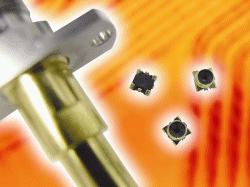Choosing the right part is integral to designing today’s wireless devices
BY GERRY HUBERS
Murata
Smyrna, GA
http://www.murata.com
Microwave switch connectors are relatively new to the electronics industry, as they first appeared in the mid 1990s as a reliable method to test a cell phone’s operation. Since that time, cell phones have drastically changed in size, weight, and functionality and as a result microwave switch connectors and the engineers who use them have had to adapt. Despite the numerous advancements in technology, microwave switch connectors, when properly selected, continue to be the component of choice throughout the prototype, production, and final assembly phases of today’s wireless products.

In a nutshell, switch connectors are predominantly designed into wireless mobile devices and were conceived during the transition from traditional whip antennas to chip devices. At the time, no reliable mechanism existed for evaluating the integrity of the data being transmitted from the antenna.
The connector interfaces with a test probe hooked up to a piece of test equipment, such as a spectrum analyzer, and enables a design or test engineer to be sure the antenna in a device such as a cell phone is working correctly.
Evolution
Switch connectors are evolving almost as quickly as the products they test. Therefore, it is essential for engineers to understand the best way to choose one that fits their needs.
Engineers are wise to consider size, reliability, operating frequency, and compatibility factors. In addition, looking ahead and anticipating the next generation of products also helps determine the ideal microwave switch connector, one that is able to seamlessly test the newest designs on the market.
Size
With the shrinking size and the increased complexity of today’s wireless products, size does matter. Traditionally, individuals would only think about a component in terms of the board space it would use, but consideration of height is now just as important as the length and width.
For example, the newest switch connectors that realize restrictions in thin designs come in a miniature package of only 2.5 x 2.5 x 1.4 mm. This reduced connector minimizes board space and accommodates challenging height barriers.
Reliability
Originally, many microwave switch connectors were designed using a very basic lever design. However, overtime it was found that metal fatigue could cause the contact point to weaken, especially if the switch connector had been used to its upper limit of maximum connections.
Ideally, a switch connector should exert constant pressure when in the closed position. This design eliminates the metal fatigue problem described above. Also, the switch connector should ensure a two-point contact at all times allowing 100 times mating and unmating of a test probe.
Another reliability factor is retaining board retention strength. The best connectors are designed to adhere to the printed circuit board using six contact points to alleviate this concern. Also, to prevent solder from wicking into the switch connector, a band of plating material should be present on each of the board terminals to avoid any soldering issues.
Operating frequency range
With the increasing number of everyday products operating in the microwave frequencies, it’s necessary that the switch connector also operate across these frequency bands. Although small in size, an ideal connector operates from dc to 6 GHz, covering today’s most popular consumer products.
Very low insertion-loss characteristics of 0.2 max and a VSWR of 1.3 max across this operating frequency are other important features available in the best connectors. Keep in mind that you should not have to sacrifice space for this capability.
Compatibility
Advanced board-mounted microwave switch connectors are designed to be compatible for high-speed production methods. These switch connectors can be mounted using automatic pick and place equipment and are completely compatible with a reflow-soldering process.
Because of the quickly decreasing size of wireless products, it is best to choose switch connectors that use the same test and production probes. This allows the design engineer to migrate to the smaller connector without the need for multiple different probes within their prototype lab or production facility. Not only does this minimizes test probe inventory, but also ensures that an incompatible probe cannot be substituted for the correct one.
Next generation
Driven by the shrinking size of mobile devices and utilizing advanced production technology capabilities, electronic companies, such as Murata, plan to offer new products that will meet the customers’ requirements of tomorrow. Constant innovative design, cost reduction techniques, mechanical design, and the extension of high-frequency capabilities are key items currently being reviewed for the next generation of microwave switch connectors. ■
More about microwave switch connectors
Want to learn more about microwave switch connectors? Electronic Products editor Ralph Raiola sat down with Murata’s Gerry Hubers, the author of this article to specifically discuss the company’s SWF Series. At the time, it was the industry’s smallest microwave switch connector, featuring a 2.5 x 2.5-mm footprint and a 1.4-mm height.
A video of the conversation — in which Hubers talks about the potential applications of microwave switch connectors, important specifications, the roadmap for future products, and much more — is available at http://hearst.feedroom.com/?fr_story=09115d343208573ad66897f2783dee7f08318c64&rf=bm.
Advertisement
Learn more about Murata Electronics North America





